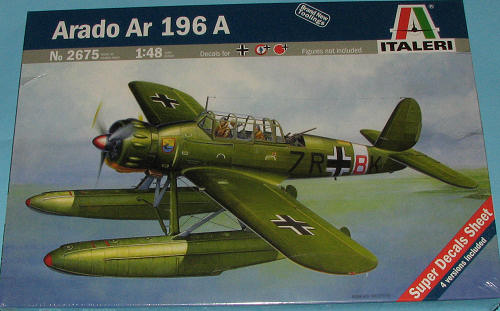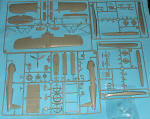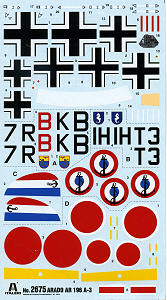
Italeri 1/48 AR-196A
| KIT #: | 2675 |
| PRICE: | $55.00 MSRP ($41.20 at www.greatmodels.com ) |
| DECALS: | Four options |
| REVIEWER: | Scott Van Aken |
| NOTES: | New Mold Kit |

| HISTORY |
The Ar 196 was a shipboard reconnaissance aircraft built by the German firm Arado starting in 1936. The next year it was selected as the winner of a design contest, and became the standard aircraft of the Kriegsmarine (German Navy) throughout World War II.
The plane was loved by its pilots, who found it handled well both in the air and on the water. With the loss of the German surface fleet the A-1s were added to coastal squadrons, and continued to fly reconnaissance missions and submarine hunts into late 1944. Two notable operations were the capture of HMS Seal, and the repeated interception of RAF Armstrong-Whitworth Whitley bombers. Although it was no match for a fighter, it was considerably better than its Allied counterparts, and generally considered the best of its class. Owing to its good handling on water, the Finnish Air Force utilized Ar 196 solely on transporting and supplying special forces patrols behind enemy lines, landing on small lakes in remote areas. Several fully-equipped soldiers were carried in the fuselage.
| THE KIT |
 After
having two less than easy 1/48 short run kits of this plane appear a few years
ago, we now have what appears to be the definitive kit of this plane in this
scale. I'm frankly surprised that it was done, but then, if you think about it,
it seems like the less mainstream stuff is the stuff that hasn't yet been kitted
properly.
After
having two less than easy 1/48 short run kits of this plane appear a few years
ago, we now have what appears to be the definitive kit of this plane in this
scale. I'm frankly surprised that it was done, but then, if you think about it,
it seems like the less mainstream stuff is the stuff that hasn't yet been kitted
properly.
There are four grey and one clear sprue. The clear sprue is well done and comes in three pieces so you can slide back the canopy to show off the interior. The grey parts are also very nicely molded and even include the hoisting cables molded to the upper fuselage just under the crew compartment. The interior is superbly done with side panels and a complete radio suite for the operator. I like it very much that decals have been included for belts. Though not as nice as some photo-etch, they are a real improvement over having nothing and I do wish more manufacturers would include this simple touch. A decal is also provided for the main instrument panel in case you don't want to paint the nicely done detailing.
A well molded engine is part and parcel of the kit. Thankfully, Italeri has molded the valve clearance parts as one piece so we don't have to mate and sand a forward and aft section. One can remove a section of the center cowling ring to show off the engine if one wishes. It was somewhat normal to see these planes carrying small bombs and Italeri provides that option.
Control surfaces are separate. Well, the flaps, elevators and rudder are separate so one can position them in something other than the neutral position if one wants. I should mention that I looked at probably a dozen period images of the plane on the water without the crew aboard and none of them showed the controls as anything but in the neutral position. Seems like another case of giving the modeler what he wants rather than what is accurate.
 Floats are a
four piece affair consisting of two lower halves, an upper section and a forward
piece. This latter bit was rubber and usually painted red. There are, as you
might guess. two large cut-outs per upper float section to fit in the large and
sturdy braces. This will need to be rigged at some time and the
instructions provide a full rigging diagram for you. It might also be helpful to
put some weight in the nose of the floats. A complete handling dolly is given to
assist in displaying the model when done.
Floats are a
four piece affair consisting of two lower halves, an upper section and a forward
piece. This latter bit was rubber and usually painted red. There are, as you
might guess. two large cut-outs per upper float section to fit in the large and
sturdy braces. This will need to be rigged at some time and the
instructions provide a full rigging diagram for you. It might also be helpful to
put some weight in the nose of the floats. A complete handling dolly is given to
assist in displaying the model when done.
Instructions are very well done. There are photo-realistic CAD drawings for the construction steps that are easy to follow. Color information is by Model Master II and RLM shades. Four markings options are provided. The box art plane is from 2.SaGr 126 based on Crete in 1941. It has yellow on the underside of the wing tips and cowling. It is RLM 73/65. Next is the Bismark scout plane from 1940 in RLM 72/73/65 in the usual splinter pattern. Next a plane with French insignia from the Auxilliary Cruiser Vidder in 1941. it also has the standard splinter scheme. The final option is from the Auxiliary Cruiser Thor in Malaya (not Malaysia as indicated as Malaysia wasn't a country until during 1941. It has RLM 72/65 paint and full Japanese roundels. The instructions shows yellow leading edge ID bands, but those were not incorporated in IJN aircraft until late 1942 at the earliest so are probably a glitch. The decal sheet is very well printed so should cause no problems. No swastika is included. In closing, I should mention that this kit is the first time I've seen the 'drawer' style box since the Testors yellow box era of the early 1980s. It is nice that they stiffen the box, but getting them back into the box is a real pain in the butt. I suggest a 'real' box with separate top and bottom.
| CONCLUSIONS |
I'm sure we'll see a full build of this in the near future as it is simply a very nicely done kit. Perhaps a bit expensive for some, but really, it is in line with most single engine prop WWII types now on the shelves.
| REFERENCES |
http://en.wikipedia.org/wiki/Ar-196
March 2010
You can get this and many other fine kits and accessories
at
www.greatmodels.com
If you would like your product reviewed fairly and quickly, please
contact
me
or see other details in the
Note to
Contributors.